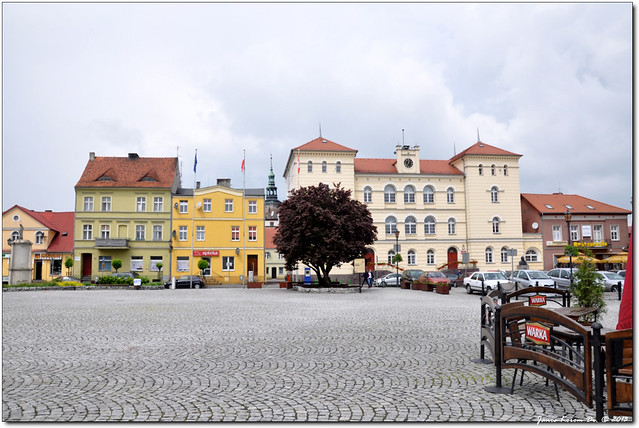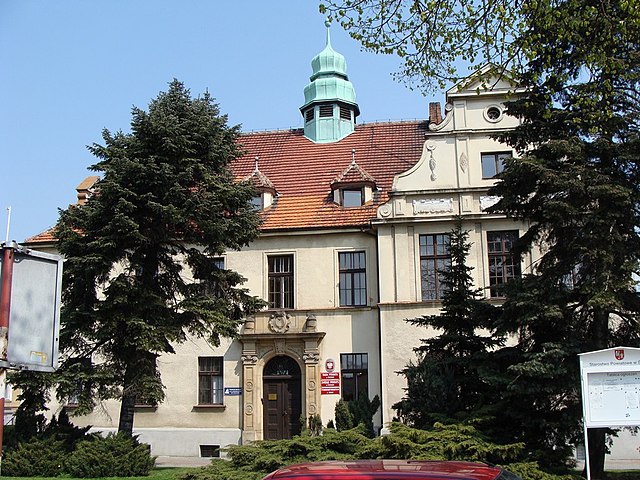Śrem

Square in Śrem with the town hall on the right. – Photo by: János Korom Dr. on Flickr
Distance
Population
30.343 (2011)
Location and history
Śrem is located in western Poland on the river Warta, south of Poznań.
Śrem first appeared in the written sources during the year 1136, where the place – here with the name form Zrem – is mentioned as an important castle. The great Polish prince Przemysł I founded here at Warta’s left river bank an actual city in 1253. This makes Erem one of the oldest towns in Wielkopolska.
In 1393 the town was moved to the slightly higher right bank. Already in the 14th century. there was a building that was the seat of the star cheese. In the later Middle Ages, the city developed strongly, among other things. due to its location on the trade route between Poznań and Wrocław, as well as the growing clothing production.
The 17th year. meant the end of the city's heyday. Śrem was destroyed and depopulated by acts of war and a plague epidemic, leaving approx. 70% of the inhabitants perished. The accidents continued in the early 18th century. with a new plague epidemic, flood and fire.
At the 2nd division of Poland in 1793, the armband came under Prussia. Although the city was under Prussian administration for many years, it managed to retain a majority of Polish inhabitants; by 1905 two thirds of the population were Polish-minded. As Prussia had become a district town under Prussian rule, and as a result of the stationing of a garrison here, the economy of the city was again advancing. The city was expanded on the left bank of the river, where most administration buildings were erected. In the second half of the 19th century. several industrial companies were established: an agricultural machine factory, a company that manufactured stoves, a sawmill, a dairy and a slaughterhouse. A railway between Śrem and Jarocin was built between 1885 and 1906.
The city was liberated from the German rule in 1918. During the interwar period, new factories were rebuilt. a malt factory; the largest company was Franciszek Malinowski’s farm machinery and horse-drawn carriage, which had its own iron foundry, employing up to 300 workers.
Already on the first day of World War II German bombs dropped over the strap. In the course of the war, more than 3,000 inhabitants of emrem and its surroundings were expelled from their homes. On October 20, 1939, 19 residents were killed by a public execution in the square, and on November 8 of that year, the murder of 12 other inhabitants followed. Emrem was liberated on 23 January 1945.
After the war, emrem continued to be a trading and service center for the area. Significant developments followed the construction of a large iron foundry which began in 1964. When the foundry production was at its peak, it employed over 4,000 workers. Such an increase in the city's economy made it possible to expand the municipal works and institutions as well as to build a new living quarters, while new service companies emerged. The population grew rapidly. In 1946 there were only 8,309 inhabitants, in 1972 it had risen to 17,315 and in 2007 to 30,477. Today, Śrem is the center of a municipality that counts more than 40,000 inhabitants, as well as a district comprising 4 municipalities.

District Town Hall in Śrem. – Photo by: KrejZii, Śrem – Starostwo1, CC BY-SA 2.5 PL
Tourist attractions
Selected attractions:
Square
bearing the name of the October 20 square, is named after the date of the execution of the Germans in the square by 19 prominent inhabitants on this day in 1939. A memorial plaque from 1946 is located in the middle of the square. where the execution took place. Since the 15th century. has a size of 160 × 90 meters. In 1393 the square stretched all the way to the parish church. Today the square is surrounded by typical 19th century houses.
City Hall
The present town hall, which is the most interesting building on the square, was built in 1838 in it “Romanesque”, common in the 19th century – with examples in Romanesque style, Italian Renaissance and classicism. The building is on three floors with 2 slightly projecting sides“wings” and a central section crowned with a small watch tower.
Church of the Assumption of Mary
The Gothic Parish Church with its tall (62 m) tower to the west constitutes a dominant element of the cityscape. The interior of the church is covered with stellar vaults. Probably the church was built immediately after the city's second founding in 1393. Originally, the church had no tower, it was built in the late 1500s. On a side altar in the church is a picture: Sankt Wojciech’s Worship of Mother of God; The artist is of course Andrzej Stuss and the picture dates from about 1620.
Franciscan
The former monastery complex originated at the transition between the 17th and the 18th century. and is surrounded by a high wall with two Baroque gates from 1770. The complex consists of the Church of the Virgin Mary of the Nativity and the former monastery. The church is the wooden ship with a narrower and older choir. The ship is covered with dome vaults, while the choir has barrel vaults. The convent buildings, which are slightly younger than the church, consist of 3 wings. These form a square monastery adjoining the church.
The courthouse
Behind the former monastery, at ul.Franciszkańska, the former Landwehr barracks are seen in classic style, which now houses the city court.
Holy Spirit
is a 1614 Gothic building. The church was rebuilt in 1840 when it was taken over by the Protestant congregation.
The water tower
from 1909 is designed by Ksawery Geisler. The tower with a height of 43.7 m is reminiscent of a Gothic defense tower. This place stood until the 17th century. St. Nicholas Church, which was the first church in the city.
Stadsparken
named after the Great Rebels 1918-1919, built 1888 and contains many old trees, statues, stadium etc.
Other parks:
The Ecological City Park, established in 1995
Foundry Worker's Park, in whose area there is also an old cemetery.
The 750-year Park, the youngest park in town.
Surrounding Area
rivers:
Warta is the third longest river in Poland. At Śrem, the course of the river turns sharply, from east-west direction to south-north direction.
Lakes:
Immediately south of the city is the very long Jezioro Grzymysławskie (Lake Grzymysław). The area of the lake is approx. 180 ha. The average depth is 3 m. The deepest places, however, are up to 11 m. At the lake there is a guarded bathing beach, and equipment for water sports can be rented.
To the northwest are 10 larger or smaller lakes.
The terrain around Śrem has been shaped at the end of the last Scandinavian ice age.
Accommodation
Booking.com
Śrem – in Polish and English (with practical information for tourists)
Other Internet sites and sources
Śrem – in Polish and English
Translated into English by Google Translate. Spangshus.dk accept no liability for any errors or omissions in translation.
Map

Rating
Search
Most used tags
churches (205) Castles (86) Monasteries (79) Town walls (74) Lakes (71) Town halls (67) Rivers (65) Castles1 (62) Mansions (55) Museums (51) Regional museums (38) Town gates (36) Abbey churches (35) Castle ruins (30) Cathedrals (26) Forests (25) Health resorts (24) Mounds (23) Water sports (23) National parks (22)Click for all tags
Denne side er også tilgængelig på dansk. This page and contents is (c) Copyright 2018- www.spangshus.dk. Based on Inviator software by ISCA Software